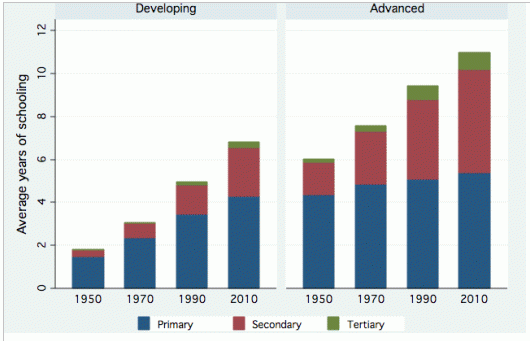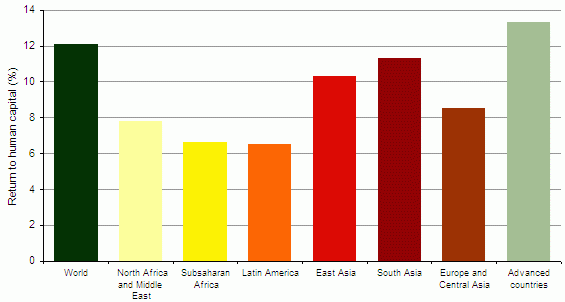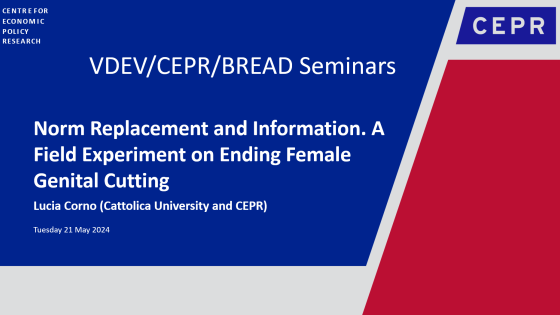It is widely accepted that human capital, particularly attained through education, is crucial to economic progress. An increase in the number of well-educated people implies a higher level of labour productivity and a greater ability to absorb advanced technology from developed countries (Acemoglu 2009). Empirical investigations of the role of human capital require accurate and internationally-comparable measures of human capital across countries and over time.
Our earlier studies (1993, 1996, and 2001) constructed measures of educational attainment of the adult population for a broad group of countries. This column introduces a new data set (available at barrolee.com) providing improved estimates for 146 countries at 5-year intervals from 1950 to 2010. The data are disaggregated by sex and by 5-year age groups among the population aged 15 years and over (see Barro and Lee 2010).
The new data improve on our widely used earlier information by using more observations of censuses, surveys, and enrolment-rate figures and by employing better methodology. We use consistent census and survey data compiled from UNESCO, Eurostat, and other sources to provide benchmarks for school attainment by gender and age group. We use enrolment-rate data to fill in missing observations at 5-year intervals by forward and backward extrapolation from the benchmark statistics. As part of this analysis, we construct new estimates of mortality rates by age and education level. We also use estimates of completion ratios applicable to each country and level of schooling.
In 2010, the world population aged 15 and over had an average 7.8 years of schooling, increasing steadily from 3.2 years in 1950 and 5.3 years in 1980. The rise in average years of schooling from 1950 to 2010 was from 6.2 to 11.0 years in high-income countries and from 2.1 to 7.1 years in low-income countries. Thus in 2010 the gap between rich and poor countries in average years of schooling remained at 4 years, having narrowed by less than 1 year since 1960 (see Figure 1). In 2010 the level and distribution of educational attainment in developing countries are comparable to those of the advanced countries in the late 1960s.
Figure 1. Average years of schooling by education level (population over age 15)
We use the new data to estimate the relationship between education and output based on a production-function approach. Our findings confirm that schooling has a significantly positive effect on output. Our estimates of rates of return for an additional year of schooling range from 5% to 12%. These estimates control for the simultaneous determination of human capital and output by using the 10-year lag of parents‘ education as an instrumental variable for the current level of schooling. These estimates are close to typical Mincerian return estimates found in the labour literature.
Estimates of rates of return to education vary across regions (Figure 2). The estimates for the group of advanced countries, East Asia and the Pacific, and South Asia are the highest at 13.3%. In contrast, the estimated rates of return are only 6.6% in Sub-Saharan Africa and 6.5% in Latin America.
Figure 2. Rates of return to an additional year of schooling, by region
Source: Country fixed-effects instrumental variable (IV) estimation in Table 6 of Barro and Lee (2010).
Results confirm that the rate of return to schooling varies across levels of education. The estimated rate of return is higher at the secondary (10.0%) and tertiary (17.9%) levels than at the primary level, which differs insignificantly from zero. The results imply that, on average, the wage differential between a secondary-school and a primary-school graduate is around 77% and that between a college and a primary-school graduate is around 240%.
Our improved dataset on educational attainment should be helpful for a variety of empirical work. For example, our previous estimates have been used to study the linkages across countries between education and important economic and social variables, such as economic growth, fertility, income inequality, institutions, and political freedom. We anticipate that the new data will help to improve the reliability of these types of analyses.
Disclaimer: The views expressed in this article are those of the authors and do not necessarily reflect the views and policies of the Asian Development Bank or its Board of Governors or the governments they represent.
References
Acemoglu, Daron (2009), “Modern economic growth”, VoxEU.org, 27 February.
Barro, RJ and JW Lee (1993), “International Comparisons of Educational Attainment”, Journal of Monetary Economics, 32:363-394.
Barro, RJ and JW Lee (1996), “International Measures of Schooling Years and Schooling Quality”, American Economic Review, 86:218-223.
Barro, RJ and JW Lee (2001), “International Data on Educational Attainment: Updates and Implications”, Oxford Economic Papers, 53:541-563.
Barro, RJ and JW Lee (2010), “A New Data Set of Educational Attainment in the World, 1950-2010”, NBER Working Paper 15902, (accompanying data are available at www.barrolee.com).





